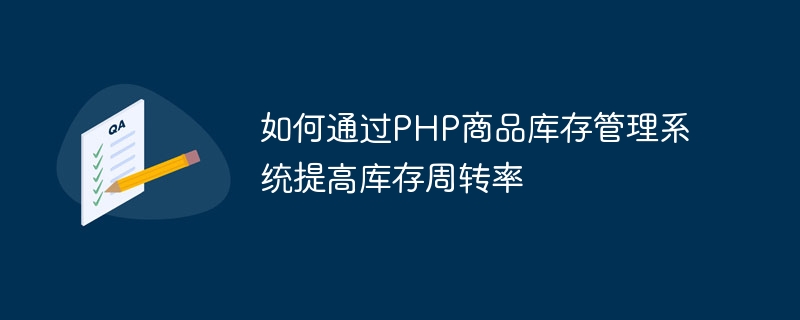Home >Backend Development >PHP Tutorial >How to improve inventory turnover rate through PHP product inventory management system
How to improve inventory turnover rate through PHP product inventory management system
- 王林Original
- 2023-08-26 11:06:351610browse

How to improve inventory turnover rate through PHP commodity inventory management system
Introduction:
With the rapid development of e-commerce, commodity inventory management has become a very important sexual aspect. A good inventory management system can effectively increase the inventory turnover rate, reduce the unsaleable inventory rate, and improve sales efficiency. This article explains how to achieve this with a PHP merchandise inventory management system and provides code examples.
1. Design the database structure
Before we begin, we need to design a suitable database structure to store product information, inventory information and other related data. The following is a simple database table structure example:
Product table (item)
- id (primary key)
- name (product name)
- price (product price)
- category_id (category ID)
Category table (category)
- id (primary key)
- name (category name)
Inventory table (inventory)
- id (primary key)
- item_id (item ID)
- stock (inventory quantity)
- sale (sales quantity)
- create_time (creation time)
2. Implementation of product management function
- Product list display:
Display the product list on the page by querying the product table (item) and category table (category). Code example:
<?php
$query = "SELECT * FROM item";
// 执行查询语句,获取结果集
$result = mysqli_query($conn, $query);
// 遍历结果集,输出商品列表
while($row = mysqli_fetch_assoc($result)) {
echo $row['name'] . " - ¥" . $row['price'] . "<br>";
}
// 释放结果集
mysqli_free_result($result);
?>- Product addition function:
Provides a form for adding product information and inserting the product information into the product table (item). Code example:
<?php
if($_POST) {
$name = $_POST['name'];
$price = $_POST['price'];
$category_id = $_POST['category_id'];
$query = "INSERT INTO item (name, price, category_id) VALUES ('$name', '$price', '$category_id')";
// 执行添加商品语句
mysqli_query($conn, $query);
}
?>
<form action="" method="POST">
商品名称:<input type="text" name="name"><br>
商品价格:<input type="text" name="price"><br>
所属分类:
<select name="category_id">
<?php
$categoryQuery = "SELECT * FROM category";
// 执行查询语句,获取结果集
$categoryResult = mysqli_query($conn, $categoryQuery);
// 遍历结果集,输出分类下拉列表
while($categoryRow = mysqli_fetch_assoc($categoryResult)) {
echo "<option value='" . $categoryRow['id'] . "'>" . $categoryRow['name'] . "</option>";
}
// 释放结果集
mysqli_free_result($categoryResult);
?>
</select><br>
<input type="submit" value="添加商品">
</form>3. Inventory management function implementation
- Inventory list display:
By querying the inventory table (inventory), the inventory list is displayed on the page . Code example:
<?php
$query = "SELECT i.name, i.price, c.name AS category, inv.stock, inv.sale FROM item AS i INNER JOIN category AS c ON i.category_id = c.id INNER JOIN inventory AS inv ON i.id = inv.item_id";
// 执行查询语句,获取结果集
$result = mysqli_query($conn, $query);
// 遍历结果集,输出库存列表
while($row = mysqli_fetch_assoc($result)) {
echo $row['name'] . " - ¥" . $row['price'] . " - " . $row['category'] . " - 库存:" . $row['stock'] . " - 销售:" . $row['sale'] . "<br>";
}
// 释放结果集
mysqli_free_result($result);
?>- Inventory change function:
Provides a form to modify the inventory quantity of goods and update the data in the inventory table (inventory). Code example:
<?php
if($_POST) {
$item_id = $_POST['item_id'];
$stock_change = $_POST['stock_change'];
$query = "SELECT * FROM inventory WHERE item_id = $item_id";
// 执行查询语句,获取结果集
$result = mysqli_query($conn, $query);
$row = mysqli_fetch_assoc($result);
$current_stock = $row['stock'];
$new_stock = $current_stock + $stock_change;
$updateQuery = "UPDATE inventory SET stock = $new_stock WHERE item_id = $item_id";
// 执行更新库存数量语句
mysqli_query($conn, $updateQuery);
}
?>
<form action="" method="POST">
商品:
<select name="item_id">
<?php
$itemQuery = "SELECT * FROM item";
// 执行查询语句,获取结果集
$itemResult = mysqli_query($conn, $itemQuery);
// 遍历结果集,输出商品下拉列表
while($itemRow = mysqli_fetch_assoc($itemResult)) {
echo "<option value='" . $itemRow['id'] . "'>" . $itemRow['name'] . "</option>";
}
// 释放结果集
mysqli_free_result($itemResult);
?>
</select><br>
库存变更:<input type="text" name="stock_change"><br>
<input type="submit" value="修改库存">
</form> Conclusion:
Through a complete PHP commodity inventory management system, the functions of commodity management and inventory management can be easily realized. Proper use of this system can improve the inventory turnover rate of goods and help automate inventory management, thereby saving time and resources and improving work efficiency. We hope that the code examples provided in this article will be helpful in implementing an efficient inventory management system.
The above is the detailed content of How to improve inventory turnover rate through PHP product inventory management system. For more information, please follow other related articles on the PHP Chinese website!

